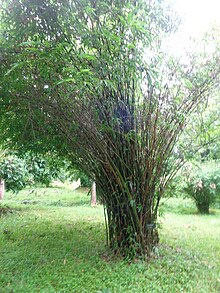| Bambusa tulda | |
|---|---|

| |
| Scientific classification | |
| Kingdom: | Plantae |
| Clade: | Tracheophytes |
| Clade: | Angiosperms |
| Clade: | Monocots |
| Clade: | Commelinids |
| Order: | Poales |
| Family: | Poaceae |
| Genus: | Bambusa |
| Species: | B. tulda
|
| Binomial name | |
| Bambusa tulda | |
| Synonyms[1] | |
|
Dendrocalamus tulda (Roxb.) Voigt | |
Bambusa tulda, or Indian timber bamboo (alternatively spineless Indian bamboo or Bengal bamboo[2]), is considered to be one of the most useful of bamboo species. It is native to the Indian subcontinent, Indochina, Tibet, and Yunnan, and naturalized in Iraq, Puerto Rico, and parts of South America.[1][3][4][5][6][7][8][9][10][11][12][13][14][15][16]
B. tulda is used extensively by the paper pulp industry in India. It can grow to a height of 15 m and a thickness of 8 cm. The single most important fact about Bambusa tulda is its incredible tensile strength; up to 60,000 pounds (27,000 Kg) per square inch. [17] It is commonly found in southeastern Asia.[18]
- ^ a b Kew World Checklist of Selected Plant Families
- ^ Monaco Nature Encyclopedia
- ^ Flora of China Vol. 22 Page 21, 俯竹 fu zhu, Bambusa tulda Roxburgh, Fl. Ind., ed. 1832. 2: 193. 1832.
- ^ Bor, N.L. (1968). Flora of Iraq 9: 1–588. Ministry of Agriculture & Agrarian Reform, Baghdad.
- ^ Karthikeyan, S., Jain, S.K., Nayar, M.P. & Sanjappa, M. (1989). Florae Indicae Enumeratio: Monocotyledonae: 1–435. Botanical Survey of India, Calcutta.
- ^ Jørgensen, P.M. & León-Yánez, S. (eds.) (1999). Catalogue of the Vascular Plants of Ecuador. Monographs in Systematic Botany from the Missouri Botanical Garden 75: i–viii, 1–1181.
- ^ Press, J.R. et al. (2000). Annotated Checklist of the Flowering Plants of Nepal: i–x, 1–430. Natural History Museum, London.
- ^ Noltie, H.J. (2000). Flora of Bhutan 3(2): 457–883. Royal Botanic Gardens, Edinburgh.
- ^ Kress, W.J., DeFilipps, R.A., Farr, E. & Kyi, D.Y.Y. (2003). A Checklist of the Trees, Shrubs, Herbs and Climbers of Myanmar. Contributions from the United States National Herbarium 45: 1–590.
- ^ Clayton, W.D., Harman, K.T. & Williamson, H. (2006). World Grass Species – Synonymy database. The Board of Trustees of the Royal Botanic Gardens, Kew.
- ^ Wu, Z. & Raven, P.H. (eds.) (2006). Poaceae. Flora of China 22: 1–733. Missouri Botanical Garden Press, St. Louis.
- ^ Newman, M., Ketphanh, S., Svengsuksa, B., Thomas, P., Sengdala, K., Lamxay, V. & Armstrong, K. (2007). A checklist of the vascular plants of Lao PDR: 1–394. Royal Botanic Gardens, Edinburgh.
- ^ Ahmed, Z.U. (ed.) (2008). Encyclopedia of Flora and Fauna of Bangladesh 12: 1–505. Asiatic Society of Bangladesh.
- ^ Lepcha, S.R., Sharma, T.P. & Das, A.P. (2009). Diversity and distribution of Bamboos in Pangolakha wildlife sanctuary in Sikkim, India. Pleione 3(1): 13–17.
- ^ Giraldo-Cañas, D. (2011). Catálogo de la familia Poaceae en Colombia. Darwiniana 49: 139–247.
- ^ Acevedo-Rodríguez, P. & Strong, M.T. (2012). Catalogue of seed plants of the West Indies. Smithsonian Contributions to Botany 98: 1–1192.
- ^ McClure, Floyd A. (1948). U.S.D.A yearbook of Agriculture-Grasses-"Bamboos for Farm and Home". Washington, DC: U.S. Dept. of Agriculture. p. 738.
- ^ Bambusa tulda Archived 2007-08-29 at the Wayback Machine, OzBamboo; Retrieved: 2007-12-19